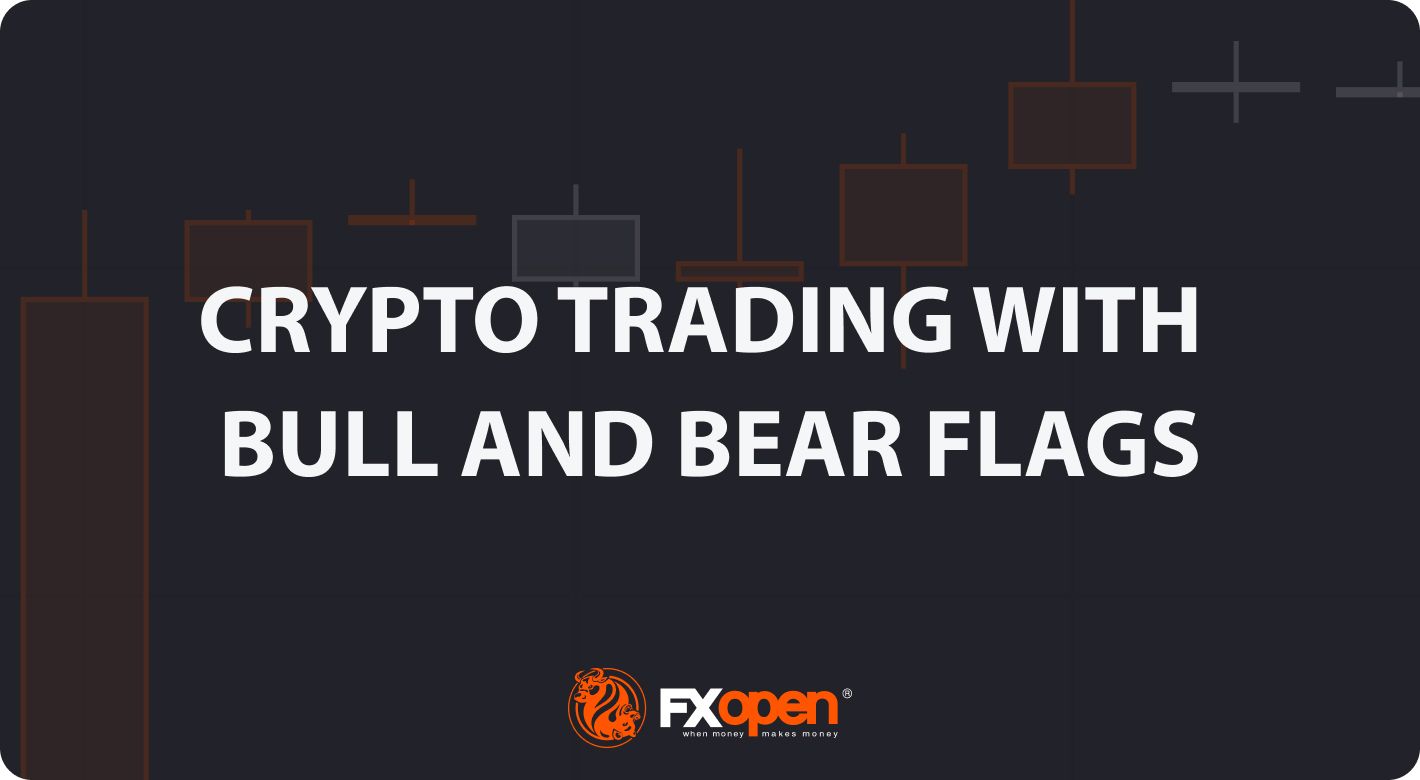FXOpen

Bull and bear flags are commonly observed chart patterns in crypto trading. Price action traders like them because they are fairly straightforward and involve specific rules. Let's explore the meaning of the bull flag and bear flag in crypto, find out how to spot them on a chart, and learn how to trade them in different market conditions.
What Are Bull and Bear Flag Patterns in Crypto?
Bullish and bearish flags are continuation patterns that appear within a strong trend.
A bull flag occurs within an uptrend and is characterised by a consolidation period after a strong price increase. It typically forms a downward-sloping channel, with the price oscillating between two parallel trendlines. The flagpole represents the initial upward price movement, while the flag itself represents the consolidation phase. Traders anticipate that the price will break out of the consolidation in the direction of the preceding trend, leading to further upward movement.
On the other hand, a bear flag appears in a downtrend. It is characterised by a consolidation period following a significant price decrease. Like the bull flag, it includes a flagpole and a flag, but in this case, it slopes upward. Traders expect the price to break out of the setup in the direction of the prevailing downtrend, leading to prolonged downward movement.
At FXOpen, you can trade flags in various crypto markets as well as in forex, stocks, indices, commodities, and ETFs.
Spotting Bull and Bear Flags on a Crypto Chart
To identify the setups on a crypto chart, look for the following characteristics:
- Prior Trend: A pattern should occur within an established uptrend (bull flag) or downtrend (bear flag).
- Flagpole: A strong, steep price movement that precedes the consolidation should form.
- Flag: A consolidation phase with the price oscillating between two parallel trendlines should form. The consolidation should be within a shallow and downward-sloping channel for a bull flag and a shallow and upward-sloping channel for a bear one.
Trading Crypto Bull and Bear Flags
When trading these formations, traders may consider the following rules:
- Entry: Traders may enter when the price breaks and closes above a bull flag's upper trendline or below the bearish flag’s lower trendline.
- Take Profit: Potential profit targets can be determined by measuring the height of the flagpole and projecting it upward for a bull flag pattern in crypto or downward for a bear flag from the breakout point. It can also be the closest support (bear) and resistance (bull) level.
- Stop Loss: A stop-loss order is typically placed below the upper boundary of the consolidation for a bull trade and above the lower boundary of the consolidation for a bear trade. Traders may consider the midpoint between the boundaries as the stop-loss level or even place it at the upper boundary in the short position and the lower boundary in a long trade. The stop-loss size will depend on price conditions and the profit target.
Live Market Example
The trader spots a bull flag on the BTCEUR chart. After a strong upward move, the price enters a consolidation phase. They decide to enter a trade when the price breaks upwards and the candle closes above the upper trendline. The take-profit target is at the distance equal to the flagpole. Additionally, they set a stop-loss order below the upper trendline to manage potential losses.
In another example, the trader spots a bear flag in crypto on the BTCUSD chart. The take profit is set by measuring the height of the pole and projecting it downwards. The stop loss is at the upper boundary of the flag.
Traders can use the user-friendly FXOpen TickTrader platform to access a diverse set of robust tools for studying and trading these setups.
Takeaway
By understanding the bull and bear flags and how to spot them on a chart, traders may make informed decisions. However, it's important to note that patterns alone do not guarantee success in trading, and other factors should be considered alongside chart analysis. Always remember to perform your own research and exercise caution when engaging in cryptocurrency trading. After gaining confidence in your trading approach, you can put your method into practice by opening an FXOpen account for live trading.
FAQ
Can bull and bear flags occur on different timeframes in crypto trading?
Yes, these formations can occur on various timeframes in crypto trading, ranging from short-term intraday charts to longer-term daily or weekly ones. Traders adjust their timeframes based on their trading strategies and goals. It's important to note that setups on higher timeframes generally carry more significance and can lead to more substantial price movements.
What risk management techniques should traders employ when trading bull and bear flag patterns in crypto markets?
Traders can employ risk management techniques when trading bull and bear flag patterns in crypto markets to limit risks. These include setting appropriate stop-loss orders to limit potential losses if the setup fails, considering the risk-to-reward ratio before entering a trade, and diversifying their trading portfolio to manage overall risk exposure. Additionally, continually monitoring the trade and adjusting stop-loss levels as the price moves can help protect profits and minimise losses.
Are there instances when bull or bear flags can lead to false signals in crypto trading?
Yes, there can be instances when these setups may result in false signals in crypto trading. Market conditions, sudden news events, or manipulation can disrupt the pattern's normal behaviour, leading to unexpected price movements. Traders should exercise caution, consider multiple factors, and use additional confirmation signals such as candlestick patterns, trendlines, or momentum indicators to reduce the risk of falling for false signals.
At FXOpen UK and FXOpen AU, Cryptocurrency CFDs are only available for trading by those clients categorised as Professional clients under FCA Rules and Professional clients under ASIC Rules, respectively. They are not available for trading by Retail clients.
This article represents the opinion of the Companies operating under the FXOpen brand only. It is not to be construed as an offer, solicitation, or recommendation with respect to products and services provided by the Companies operating under the FXOpen brand, nor is it to be considered financial advice.
Stay ahead of the market!
Subscribe now to our mailing list and receive the latest market news and insights delivered directly to your inbox.








